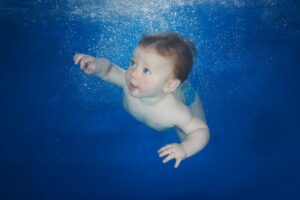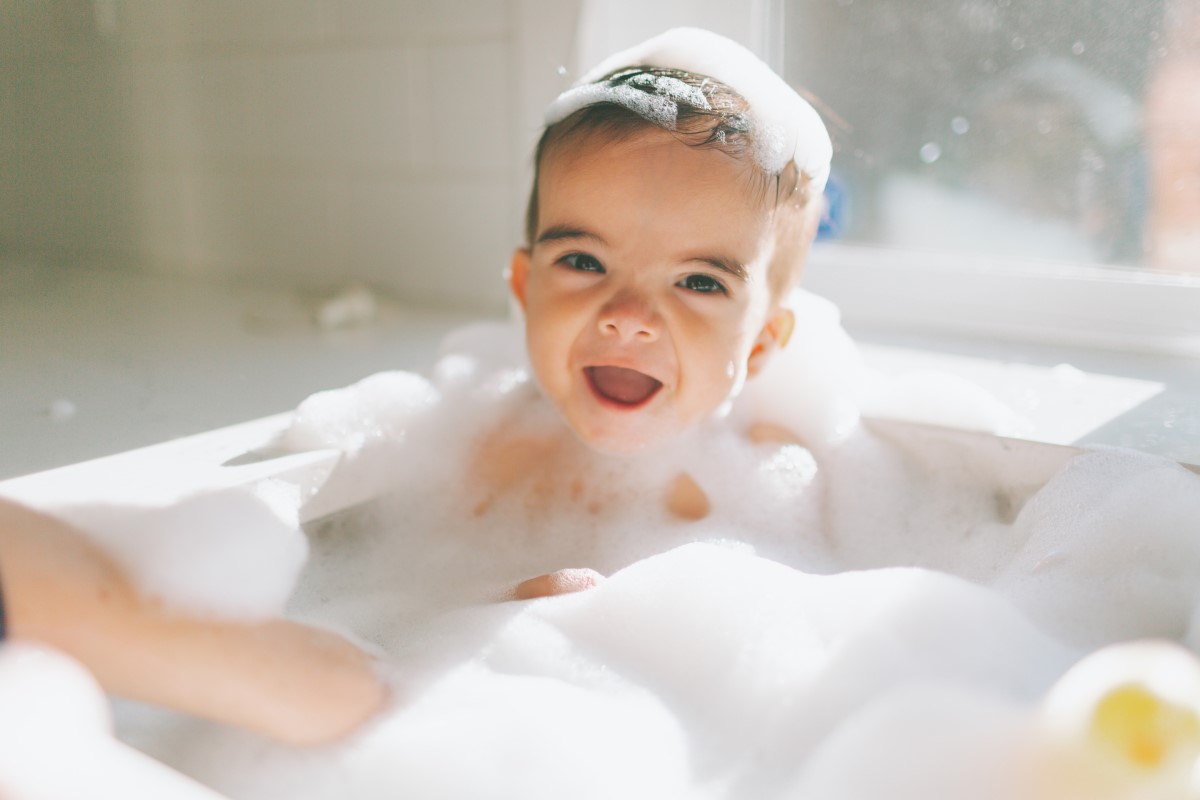
When babies come into the world, they are not typically scared of water. Most lose their sense of bravery in the water around 12 months old. Make sure your baby is ready for swimming lessons by using bath time activities to get them excited about the water.
Children as young as 3 months old can try out the pool for the first time. Although the majority of parents may be more comfortable introducing their children to water in a controlled environment. Bath time is a perfect way to introduce them to swim time! Fill the bathtub and hop in with your child to help get them comfortable in the water. Bath time makes the transition into the pool later in life much easier. It’s also another way to spend quality time with your kids!
Some Things to Keep in Mind for Bath Time:
- Bathing does not increase the risk of infection to an umbilical cord stump. You do not need to wait for the stump to heal over completely before introducing your newborn to the tub.
- Set aside a specific time for bathing. This will give you enough time to give your child your undivided attention with minimal interruptions.
- Bathing before bedtime helps your baby relax and sleep better.
- Avoid baths before or after feeding. A hungry baby will not be able to relax and enjoy bathing. While a full baby has the risk of spitting up.
- Never leave your child unsupervised or alone. If you need to leave the bathroom to answer the door or the phone, wrap your baby in a towel and take them with you.
- It’s important to ensure the air and bath temperatures are safe and comfortable for your baby’s sensitive skin. Aim for bath water 100℉ (38℃). The room should be fairly warm too. A wet baby can get cold fairly easily.
Bath Time Activities:
1) Use Verbal Cues
Communicating can be done by exchanging ideas both verbally and non-verbally. Most children learn to communicate to fulfill their needs or interact with loved ones like a parent. Tell your child what you are doing in the water. This will help children connect words with objects and actions.
Verbal cues strengthen your child’s word association abilities. It also prepares them to pick up verbal cues from others. Examples include “splash” when you or your child are splashing in the water and “kick” when you or your child are kicking in the water. Think of this like and show and tell!
2) Practice Submerging
Practice submerging your child into the water. This will help your little one get comfortable with the sensation of wetness and floating. Try this with different parts of the body before wetting the face and going fully underwater.
There are 3 positions you can place your baby in. Each one feels different, but they all let your baby feel what it’s like to be underwater.
Position One
This is the first technique you should use to get your baby comfortable with the feeling of water. It’s gradual. So it helps your child get a feel for being submerged in the water.
- Lower yourself into the water while lying on your back.
- Place your child stomach down on your chest or stomach. The two of you should be snuggling together.
- Gently pour a cup of water over your baby’s back. This will give them a warm sensation of the water going over their skin.
Once your child is comfortable with the sensation of water, move on to the next position.
Position Two
After pouring water on your baby, it’s time to get them a little wetter. This method involves sitting up and cradling your child in front of you between your legs.
- Place one hand behind your baby’s neck and the other behind their lower back.
- Slowly lower your baby into the water. The back of the baby’s head and ears should be in the water.
- With their face out of the water, continue to support your child’s head.
- Once comfortable in this position, you may remove your hand from your baby’s back to give them more independence.
This position is great because your child still has face-to-face contact with you. This makes the water a little less scary because they know you are there to support him or them.
Position Three
The third position involves the baby being held tummy down with the parent seated. Always make sure to support your baby to avoid their noses or mouths going into the water.
- Keep your hands under your baby’s armpit with your thumbs pointing upwards.
- Rotate the palms of your hands to allow the wrists to come together. This helps support your baby’s chin and lets their head rest on your hands.
- Let your baby lie horizontally in the water while supporting their head. Their backside should be close to the water’s surface.
- Gently glide the baby from side-to-side and back-and-forth.
Babies enjoy this prone position. It lets them move and extend their legs in a way that’s not possible on land. Babies can also push off the end of the bathtub. This strengthens the legs and gives them a better sense of security.
Wetting the Face
The next part is wetting your child’s face for the first time. Follow the steps for the best results.
- Sit your child in your lap facing you.
- Gently wipe your child’s face with a wet washcloth. Try to smile because the two of you have eye contact.
- Cup your hand and scoop some water. Slowly pour the water onto your child’s head. Do this until your child seems comfortable.
- Lightly splash and get them to splash you back.
Face wetting is the first part of wetting your child’s face. Our article Is It Safe to Dunk a Baby Underwater? explains more about full submersion.
3) Breathing Exercises
Once your child is used to getting wet, it’s time to practice breathing. Babies can be taught to hold their breath. This is done by gently pouring a small amount of water onto their face. In the bathtub, try some of these techniques to teach your child how to hold their breath.
- Take a brightly coloured cup of water to get your child excited.
- Use the cup as a visual cue to gain your child’s attention.
- Use your child’s name and say “Ready? Go!” and then pour a cup of water evenly across the head. The cue, “Name, Ready, Go!’ is important. The phrase tells your child to hold their breath.
- Be your child’s biggest cheerleader. Positive reinforcement increases your child’s confidence and relaxation. It also makes being in the water something to look forward to.
Following these steps improves your child’s breath-holding capacity.
4) Try Unassisted Floating
Floating without help is the next step. Once your child is comfortable in all three positions, follow this process.
- Lay your child on their back and hold them in the floating position. Encourage them to relax.
- Gently and slowly release your support.
- Gradually let go while keeping your hands underneath the water in case your baby needs support still.
It’s important to pay attention during this process. Babies learn to float at different paces. So some may need more support than others.
5) Blow Bubbles!
Try blowing bubbles in the water using the mouth. Show your baby how to do this repeatedly. This encourages skill development and doing things together makes them more fun!
There are a variety of games and activities to help your baby learn to blow bubbles. Bring some ping pong balls into the tub. See who can blow one the furthest. You can also try making funny noises while blowing in the water. Maybe pretend to be a fire-breathing dragon!
Blowing soap bubbles is another fun option! Blowing soap bubbles is the same thing, but they float around and last longer. This action can help your child associate the action with a result. It can be helpful to children who have trouble getting the concept down.
6) Sing Songs!
Singing songs in the bathtub is a form of using verbal cues. Songs help anyone learn and remember. They use rhymes to help children learn vocabulary and communication skills. Songs benefit your child when helping them get accustomed to the water. Studies suggest music and movement have benefits such as the ones listed below.
- Encourages brain development
- Supports listening, motor skills, language, problem-solving, spatial-temporal performance and literacy
- Developing critical listening skills
- Creates space for emotional well-being
- Provides opportunities to practice social skills
- Increases understanding of words and syllables
- Acts of kindness and cooperation become more common
- Calms and focuses the mind
- Fosters interaction in non-threatening ways
Take a look at these 7 Silly Bathtime Songs you can sing to your child when it’s time to rubadubdub!
7) Item Interaction
Developing fine motor skills allow your child to move more freely in the water. Bath toys or household items are a great way to begin this process. Toys can distract children from getting upset and let them focus on an activity. A squirting toy can be used for face wetting. Let them squirt you and then themselves. Toys are good devices for learning alongside other bathtime activities!



